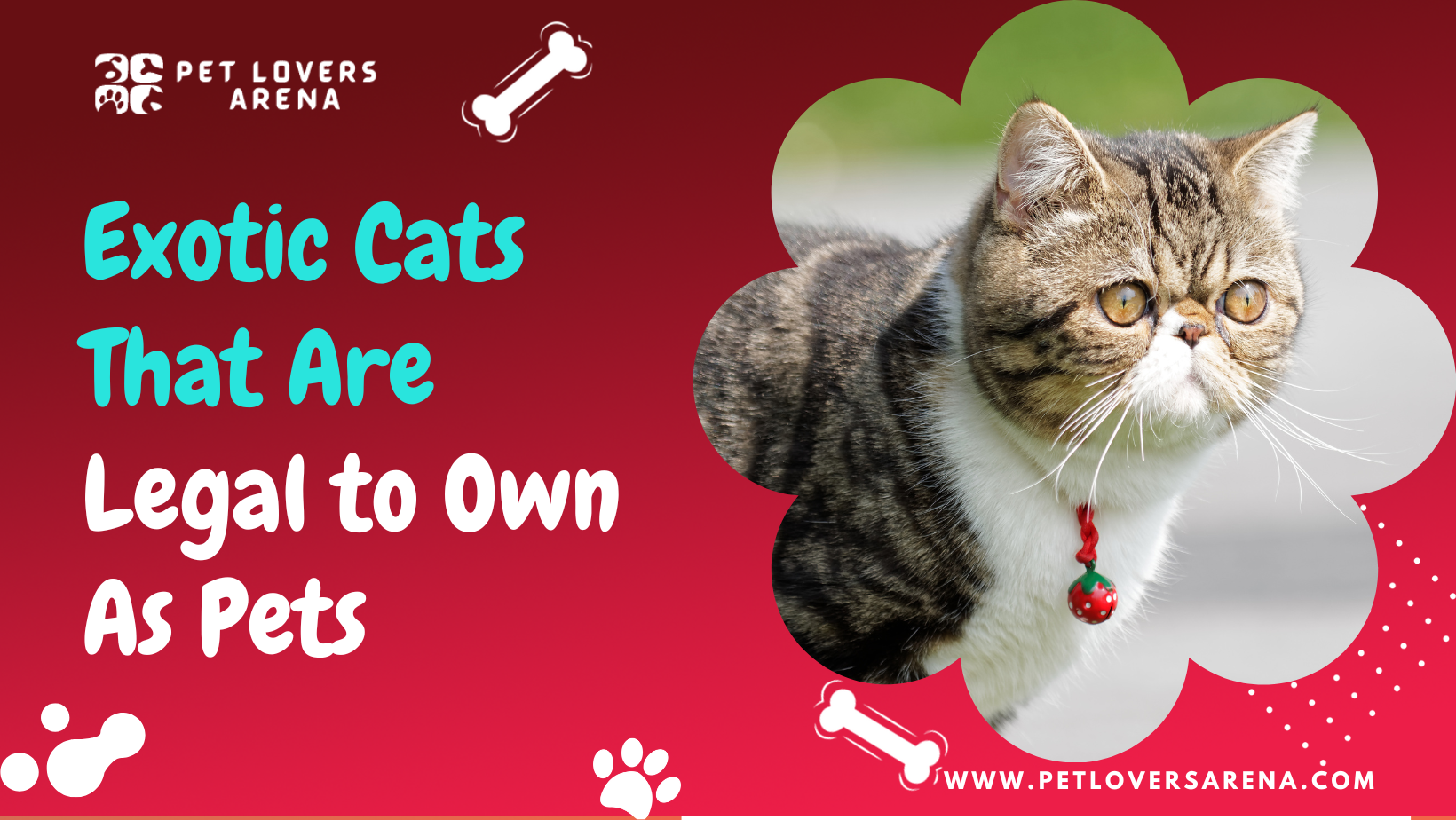You might consider getting an exotic cat if you’re looking for a unique and exotic pet. While some exotic cats are illegal to own, several breeds are legal in the United States. These cats can make great pets for the right owner, but it’s important to understand their needs and requirements before bringing one home.
Each breed has unique characteristics and requirements, so it’s important to research and choose the one that’s right for you. Remember that owning an exotic cat is a big responsibility, and you’ll need to provide them with a safe and secure enclosure, a healthy diet, and plenty of love and attention.
Key Takeaways
- Exotic cats can make excellent pets, but it is important to choose the right breed and understand their needs and requirements.
- The Savannah cat is one of the most popular exotic cats legally owned, but requires a lot of space and attention.
- Other legal exotic cat breeds include the Bengal cat, the Egyptian Mau, and the Ocicat, each with unique characteristics and requirements.
Exotic Cats That Are Legal to Own as Pets
Each breed has a unique personality, dietary needs, and a native habitat. As you read further about the cats, you will be guided through their scientific name and characteristics as well. So ensure you get all the information and read about each cat thoroughly. Here is the list of the most popular exotic cat breeds that can be domesticated:
1. Servals
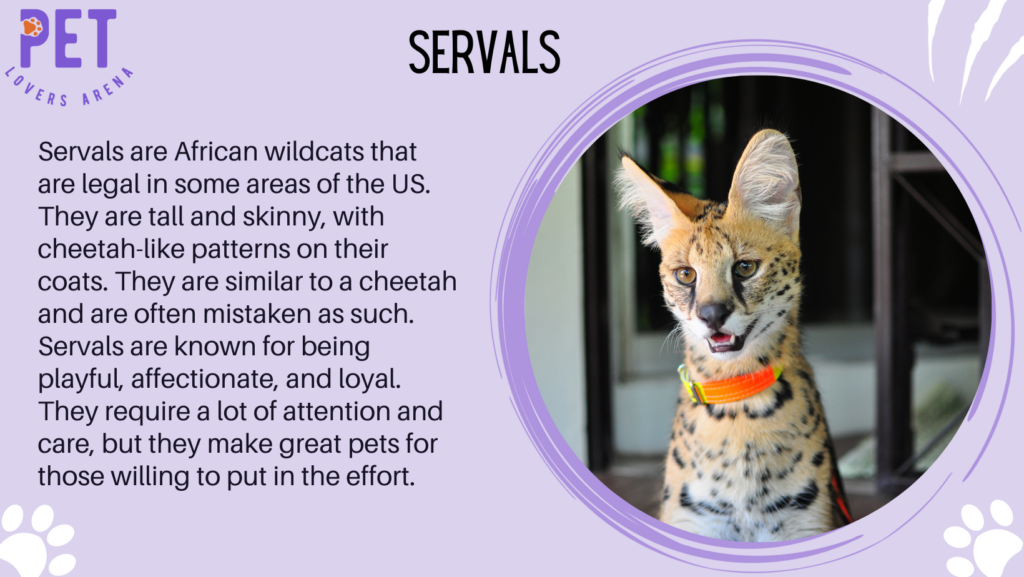
Servals are African wildcats that are legal in some areas of the US. They are tall and skinny, with cheetah-like patterns on their coats. They are similar to a cheetah and are often mistaken as such. Servals are known for being playful, affectionate, and loyal. They require a lot of attention and care, but they make great pets for those willing to put in the effort.
- Scientific Name: Leptailurus Serval
- Native Habitat: It is a wild cat native to Africa. These cats have been present in Africa for thousands of years. They are believed to have originated in the savannahs of sub-Saharan Africa.
- Size: They are medium-sized cats, with males weighing up to 40 pounds and females weighing up to 25 pounds. They are larger than most domestic cats and have a lean, muscular build.
- Diet: Serval cats require a diet high in protein and low in carbohydrates. They should be fed a balanced diet of raw or cooked meat supplemented with vitamins and minerals. It’s important to avoid feeding them commercial cat food, which is not suitable for their nutritional needs.
- Lifespan: Serval cats live up to 20 years in the wild, but if they are domesticated, their lifespan changes; that is, they live up to 10 to 12 years in the house environment.
2. Bobcats
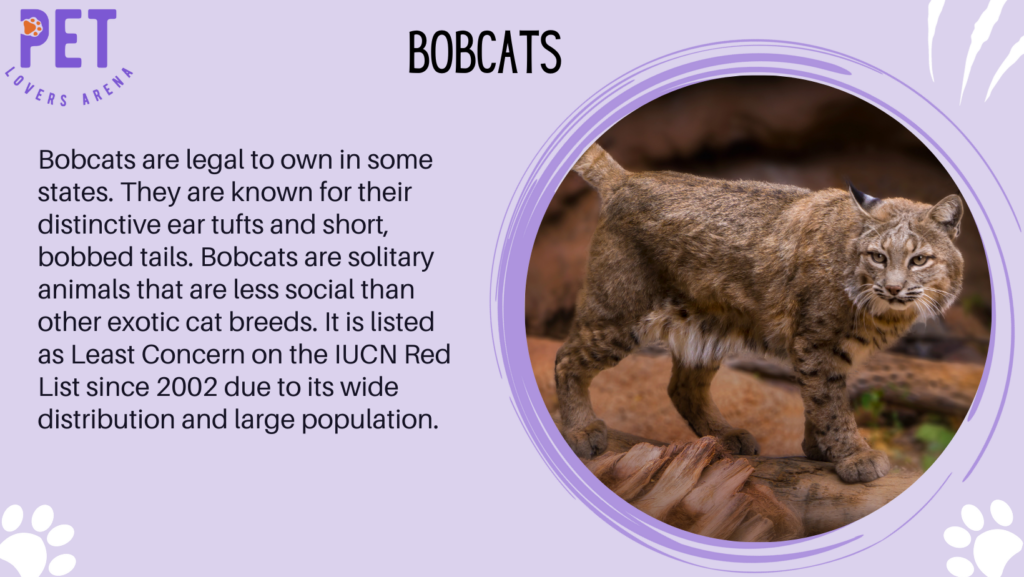
Bobcats are legal to own in some states. They are known for their distinctive ear tufts and short, bobbed tails. Bobcats are solitary animals that are less social than other exotic cat breeds. It is listed as Least Concern on the IUCN Red List since 2002 due to its wide distribution and large population.
- Scientific Name: Lynx rufus
- Native Habitat: This cat is native to North America
- Size: Adult bobcats weigh 15–35 pounds and measure 28–47 inches. Size varies depending on sex, as male bobcats are approximately 33% larger than their female counterparts.
- Diet: Bobcats mostly eat rabbits and hares. They may also eat rodents, such as squirrels and mice, or hunt small deer, snakes, lizards, and domestic animals, such as dogs, cats, sheep, goats, and poultry. They can even leap high enough to catch low-flying birds.
- Lifespan: Most bobcats live between five and 15 years in the wild. The median life expectancy of a bobcat in human care is about 18 years.
3. Caracal Cats
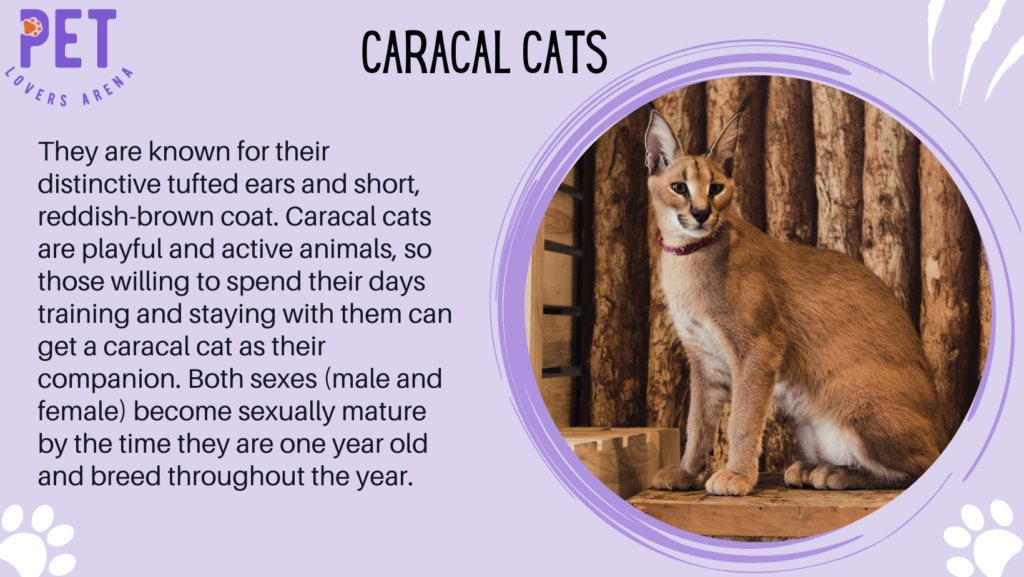
They are legal to own in some areas of the US. They are known for their distinctive tufted ears and short, reddish-brown coat. Caracal cats are playful and active animals, so those willing to spend their days training and staying with them can get a caracal cat as their companion. Both sexes (male and female) become sexually mature by the time they are one year old and breed throughout the year.
- Scientific Name: Felis caracal
- Native Habitat: This wild cat is native to Africa, the Middle East, Central Asia, and arid areas of Pakistan and northwestern India.
- Size: Caracals have a shoulder height between 16”-20” (41-51 cm), a body length of 24”-42” (61-107 cm), and a weight in the range of 15-45 lb (7-20 kg). The tail of a Caracal is 9”-13” (23-33 cm) in length.
- Diet: Caracals are strict carnivores and mainly eat hyraxes, hares, antelopes, rodents, small monkeys, and birds. They may scavenge at times. The fluids from their prey meet their water needs, so they can survive without consuming much water.
- Lifespan: Caracals live approximately 12 years in the wild and 17 years in human care.
4. Canadian and Siberian Lynxes
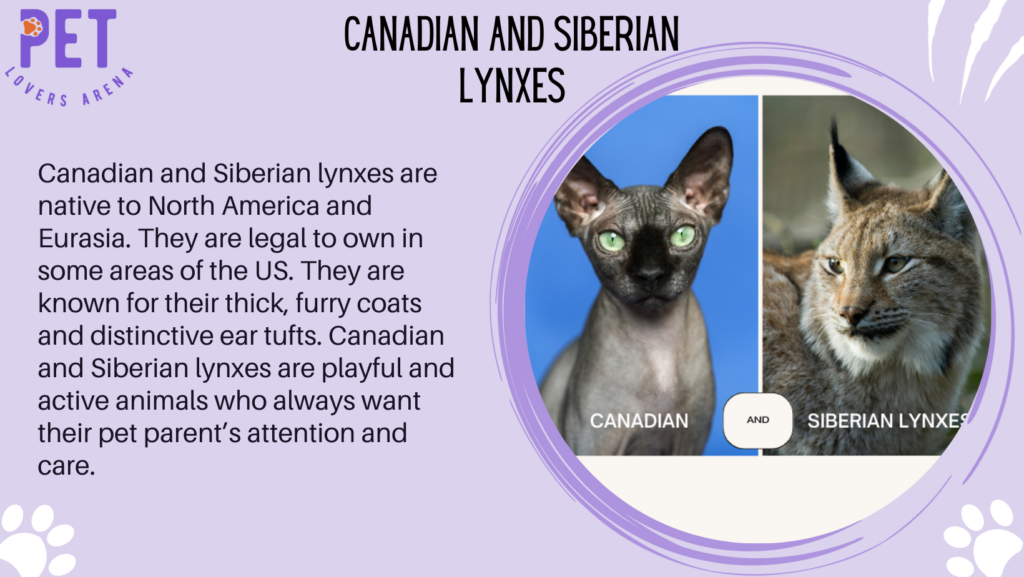
Canadian and Siberian lynxes are native to North America and Eurasia. They are legal to own in some areas of the US. They are known for their thick, furry coats and distinctive ear tufts. Canadian and Siberian lynxes are playful and active animals who always want their pet parent’s attention and care.
Canadian
- Scientific Name: Lynx canadensis
- Native Habitat: Canadian lynx that ranges across Alaska, Canada, and northern areas of the contiguous United States.
- Size: The weight of an adult ranges from 8.0 to 17.3 kg (about 18 to 38 pounds), and its length ranges from 67 to 107 cm (about 26 to 42 inches).
- Diet: About 75% of the lynx’s diet comprises the snowshoe hare. It also eats birds, meadow voles, carrion, and sometimes larger animals like deer and caribou.
- Lifespan: The life span of both sexes usually falls between 10 and 20 years.
Siberian
- Scientific Name: Lynx lynx wrangeli
- Native Habitat: This cat lives in the Russian Far East, Korea, Mongolia, and China (Manchuria and eastern Inner Mongolia).
- Size: It is the largest of the four lynx species, ranging in length from 80 to 130 cm (31 to 51 in) and standing 60–75 cm (24–30 in) at the shoulder. The tail measures 11 to 24.5 cm (4.3 to 9.6 in) in length.
- Diet: Its list of prey animals is very long, ranging from small rodents and birds to animals the size of deer and reindeer.
- Lifespan: Siberian lynx lives to an average age of 15 years.
5. Ocelots
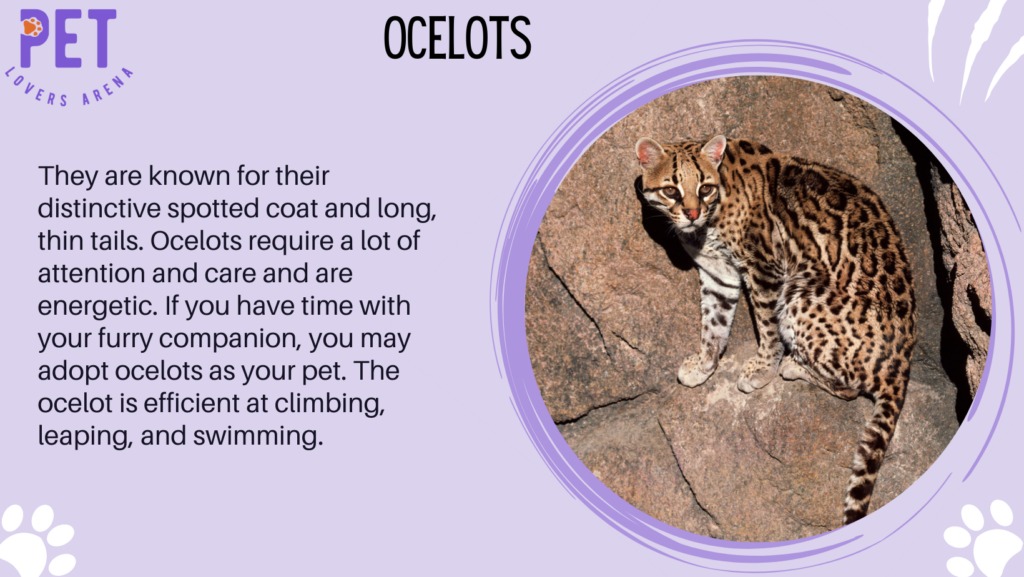
Ocelots are legal to own in some areas of the US. They are known for their distinctive spotted coat and long, thin tails. Ocelots require a lot of attention and care and are energetic. If you have time with your furry companion, you may adopt ocelots as your pet. The ocelot is efficient at climbing, leaping, and swimming. It prefers areas close to water sources with dense vegetation cover and high prey availability.
- Scientific Name: Leopardus pardalis
- Native Habitat: It is native to the southwestern United States, Mexico, Central and South America, and the Caribbean islands of Trinidad and Margarita.
- Size: The ocelot is a medium-sized spotted wild cat that reaches 40–50 cm (15.7–19.7 in) at the shoulders and weighs between 7 and 15.5 kg.
- Diet: Ocelots mainly consume small rodents. Their diet includes birds, snakes, lizards, baby peccaries, young deer, rabbits, fish, and crabs. They are nocturnal and typically hunt at night. Ocelots actively look for prey while on the move or wait for prey to appear.
- Lifespan: Ocelots live about 12 years in the wild. In captivity, they can live up to 20 years.
6. Fishing Cats
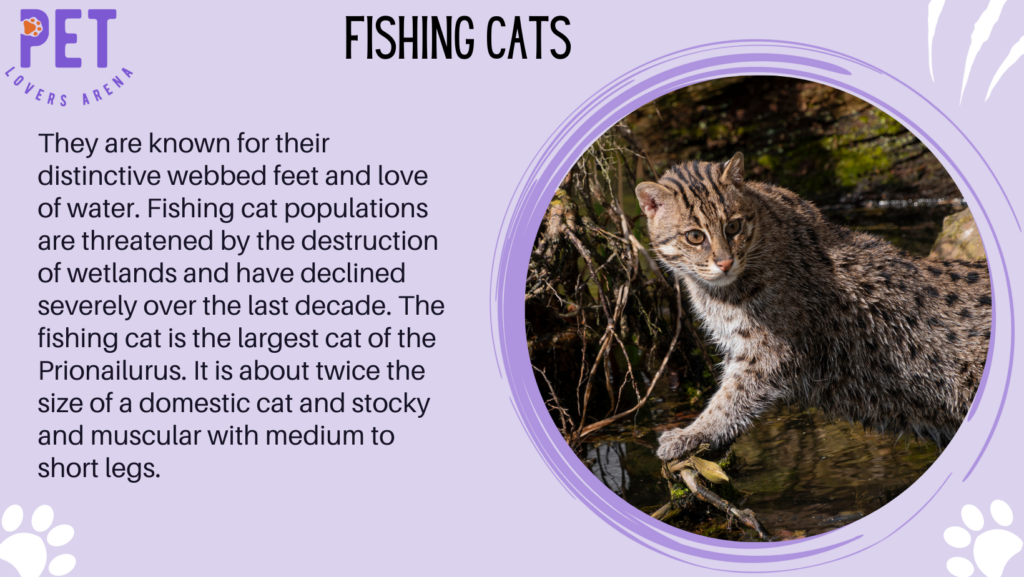
The name says it all. They are legal to own in some areas of the US. They are known for their distinctive webbed feet and love of water. Fishing cat populations are threatened by the destruction of wetlands and have declined severely over the last decade. The fishing cat is the largest cat of the Prionailurus. It is about twice the size of a domestic cat and stocky and muscular with medium to short legs.
- Scientific Name: Prionailurus viverrinus
- Native Habitat: Fishing cats are native to Southeast Asia.
- Size: This robust, deep‐chested cat has a body length of 33-45 inches (85-115 centimeters) and stands over 16 inches (40 centimeters) at shoulder height.
- Diet: Fishing cats are generalists who opportunistically feed on what is available. They primarily eat small mammals and fish. Birds also constitute a small portion of their diet. They have been observed eating shellfish and other small prey, such as lizards and amphibians.
- Lifespan: The lifespan of this cat is 10 to 12 years.
7. Geoffroy’s Cats
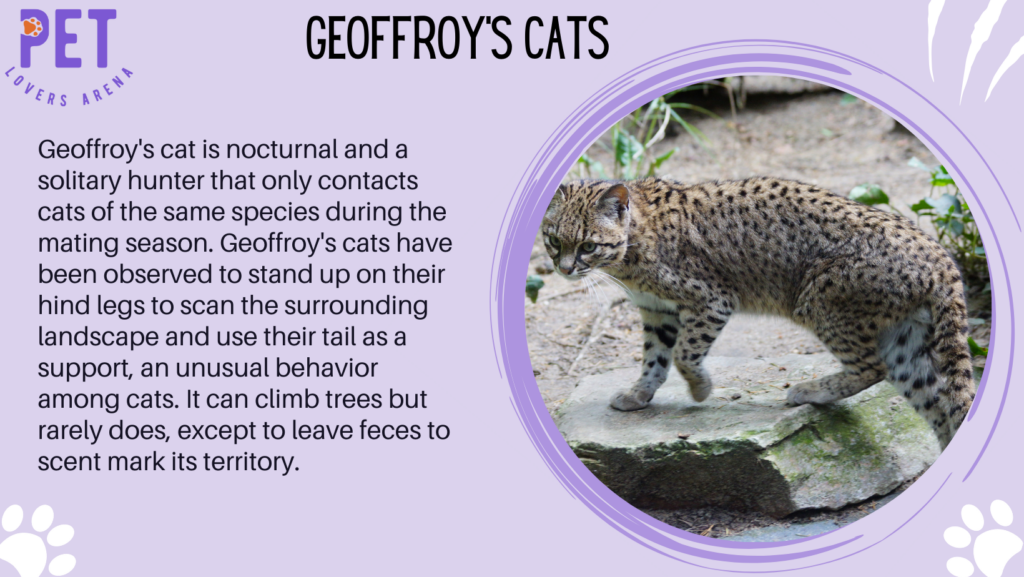
Geoffroy’s cat is nocturnal and a solitary hunter that only contacts cats of the same species during the mating season. Geoffroy’s cats have been observed to stand up on their hind legs to scan the surrounding landscape and use their tail as a support, an unusual behavior among cats. It can climb trees but rarely does, except to leave feces to scent mark its territory.
- Scientific Name: Leopardus geoffroyi
- Native Habitat: Geoffroy’s cat is a small wild cat native to South America’s southern and central regions.
- Size: It is about the size of a domestic cat. It grows to a length of about 90 cm (36 inches), including a tail of about 40 cm (16 inches).
- Diet: In most populations, the diet is dominated by small rodents and birds. More oversized prey items include hares, flamingos, Armadillos, and tree porcupines. Other prey include reptiles, amphibians, crabs, fish, and bugs.
- Lifespan: Geoffroy’s cat has a lifespan of 18 years.
8. Asian Leopard Cats
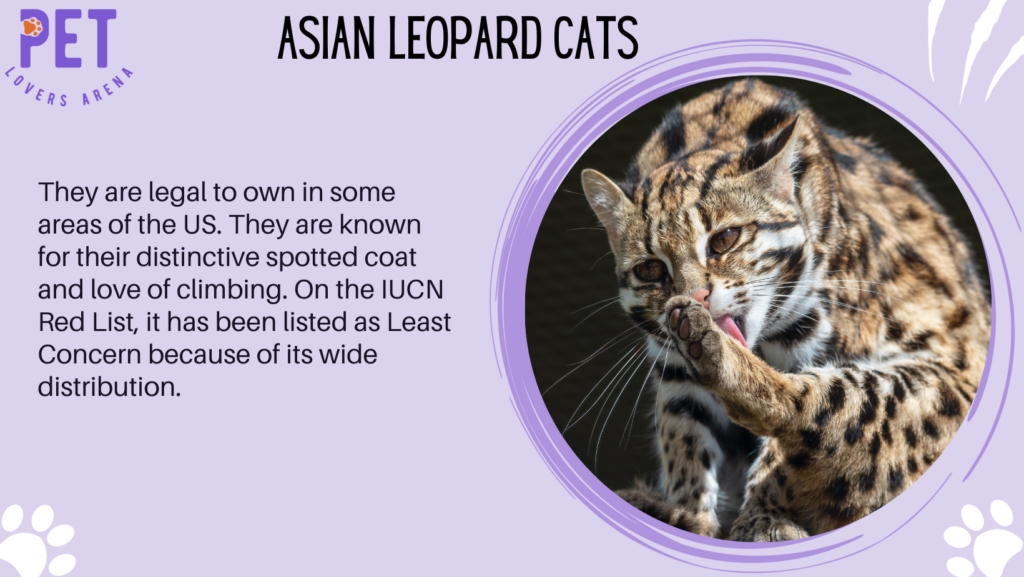
They are legal to own in some areas of the US. They are known for their distinctive spotted coat and love of climbing. On the IUCN Red List, it has been listed as Least Concern because of its wide distribution.
- Scientific Name: Prionailurus bengalensis
- Native Habitat: The leopard cat is a small wild cat native to continental South, Southeast, and East Asia.
- Size: Leopard cats weigh 0.55–3.8 kg (1.2–8.4 lb), have head-body lengths of 38.8–66 cm (15.3–26.0 in), with long 17.2–31 cm (6.8–12.2 in) tails.
- Diet: Leopard cats are carnivorous, feeding on various small prey, including mammals, lizards, amphibians, birds, and insects. In most of their range, small rodents such as rats and mice form a significant part of their diet, often supplemented with grass, eggs, poultry, and aquatic prey.
- Lifespan: Leopard Cats can live for 10 to 13 years.
9. Toyger
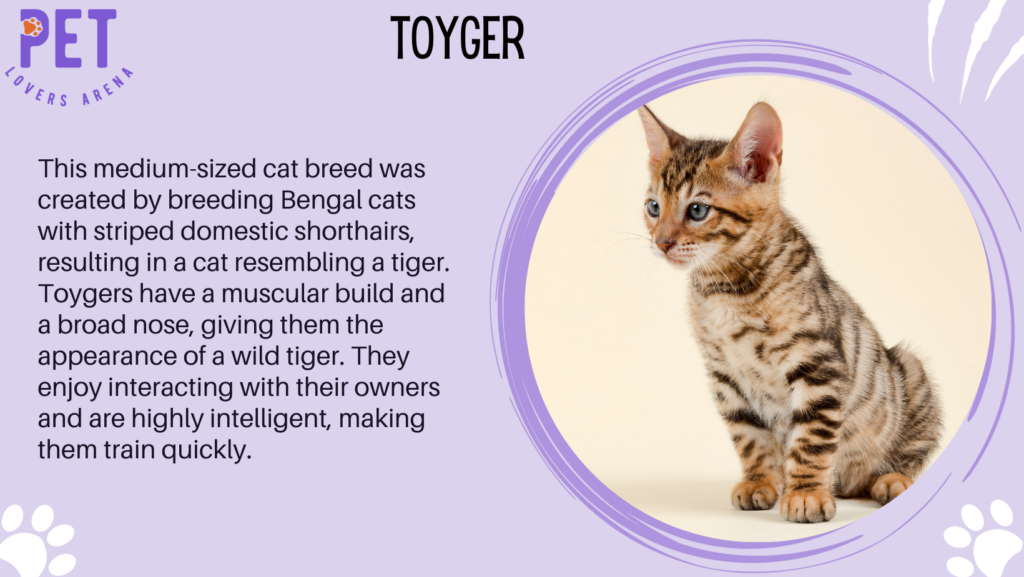
If you’re looking for a domestic cat resembling a miniature tiger, the Toyger might be the perfect pet. This medium-sized cat breed was created by breeding Bengal cats with striped domestic shorthairs, resulting in a cat resembling a tiger. Toygers have a muscular build and a broad nose, giving them the appearance of a wild tiger. They enjoy interacting with their owners and are highly intelligent, making them train quickly.
- Scientific Name: The scientific name for the Toyger is Felis catus.
- Native Habitat: United States
- Size: The toyger stands at 9–13 inches tall and weighs between 7–15 pounds.
- Diet: Toygers are carnivores, and their diet should consist mainly of high-quality protein sources such as meat.
- Lifespan: They have a lifespan of around 12-15 years.
10. Bengal
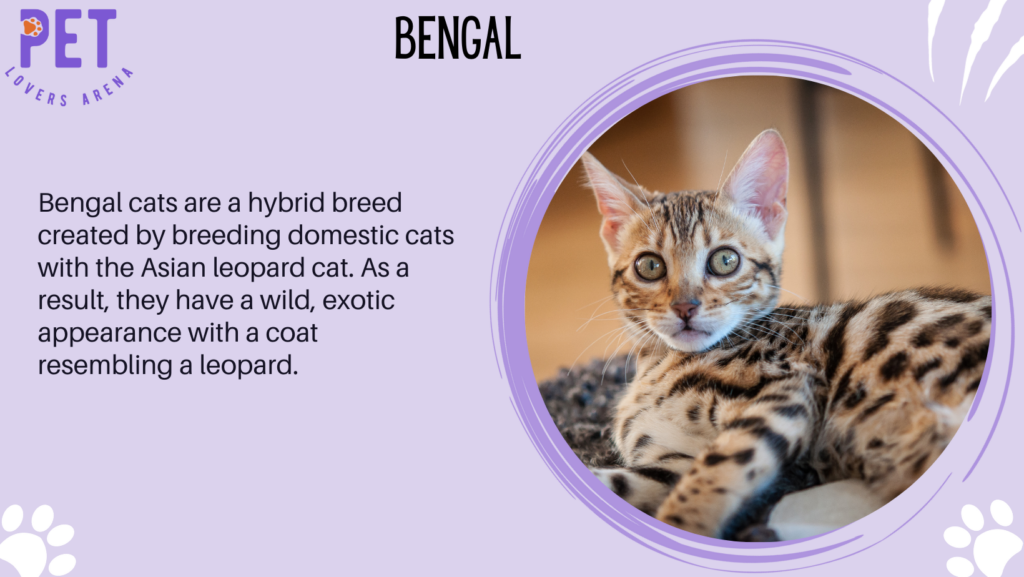
If you’re looking for a cat that looks like a wild animal but acts like a domesticated pet, the Bengal cat may be for you. Bengal cats are a hybrid breed created by breeding domestic cats with the Asian leopard cat. As a result, they have a wild, exotic appearance with a coat resembling a leopard.
- Scientific Name: The scientific name for the Bengal cat is Felis catus x Prionailurus bengalensis.
- Native Habitat: The Asian leopard cat is native to Asia and can be found in countries like India, Bangladesh, and Vietnam.
- Size: They are medium-sized cats and can weigh anywhere from 8 to 15 pounds.
- Diet: Bengal cats are obligate carnivores, meaning they require a diet mainly of meat. A high-quality commercial cat food that lists meat as the first ingredient is recommended. You can also feed them raw or cooked meat, but it’s important to ensure the meat is fresh and free from harmful bacteria.
- Lifespan: Bengal cats have a lifespan of 12 to 16 years.
11. Ocicat
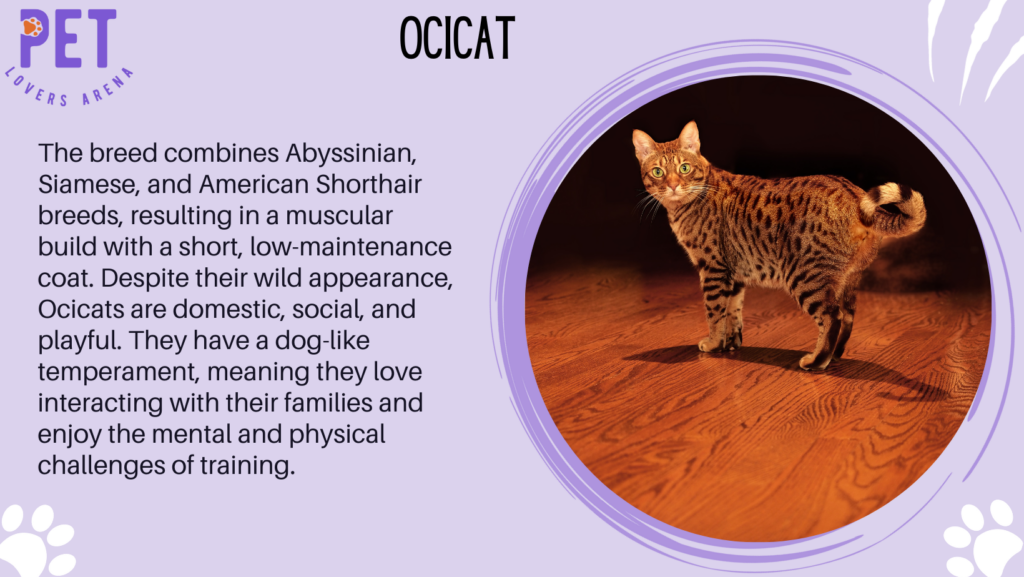
The breed combines Abyssinian, Siamese, and American Shorthair breeds, resulting in a muscular build with a short, low-maintenance coat. Despite their wild appearance, Ocicats are domestic, social, and playful. They have a dog-like temperament, meaning they love interacting with their families and enjoy the mental and physical challenges of training.
- Scientific Name: The scientific name for the Ocicat is Felis catus.
- Native Habitat: The Ocicat is native to Central and South America.
- Size: They grow to be about 15 pounds, much like a large house cat.
- Diet: As with all cats, the Ocicat needs a diet high in protein. High-quality dry food and wet food are both excellent choices. Additionally, you can supplement their diet with small amounts of cooked chicken or fish.
- Lifespan: The Ocicat has a lifespan of 12-18 years.
12. Cheetoh
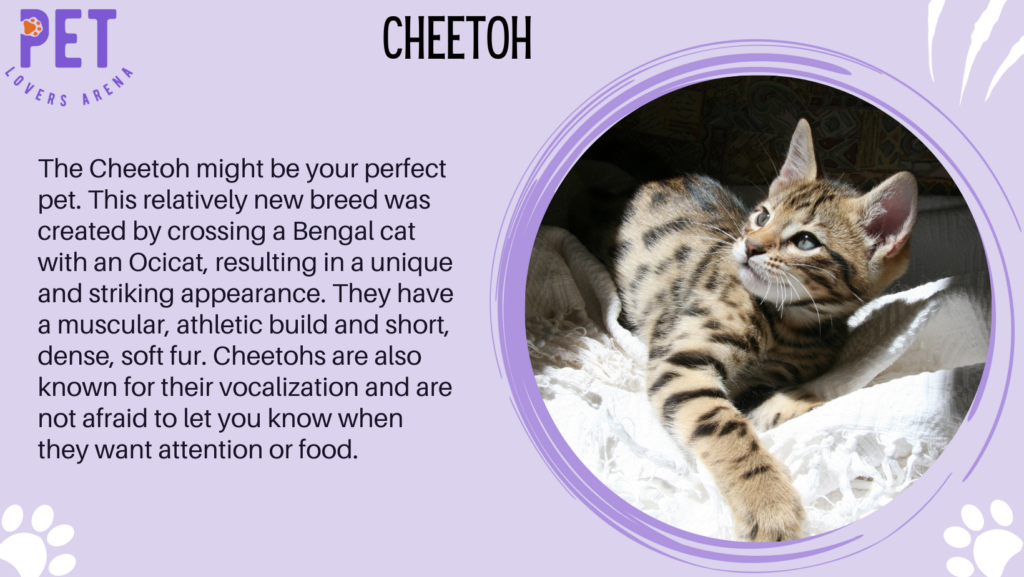
If you’re looking for a large, affectionate, and exotic cat breed, the Cheetoh might be your perfect pet. This relatively new breed was created by crossing a Bengal cat with an Ocicat, resulting in a unique and striking appearance. They have a muscular, athletic build and short, dense, soft fur. Cheetohs are also known for their vocalization and are not afraid to let you know when they want attention or food.
- Scientific Name: The scientific name for the Cheetoh cat is Felis catus.
- Native Habitat: United States
- Size: Cheetoh cats can weigh between 15 and 23 pounds, with males being larger than females.
- Diet: In terms of diet, Cheetohs require a high-quality, protein-rich diet that’s appropriate for their age and activity level. You should feed your Cheetoh with occasional treats.
- Lifespan: The average lifespan of a Cheetoh cat is 10-15 years.
13. Egyptian Mau
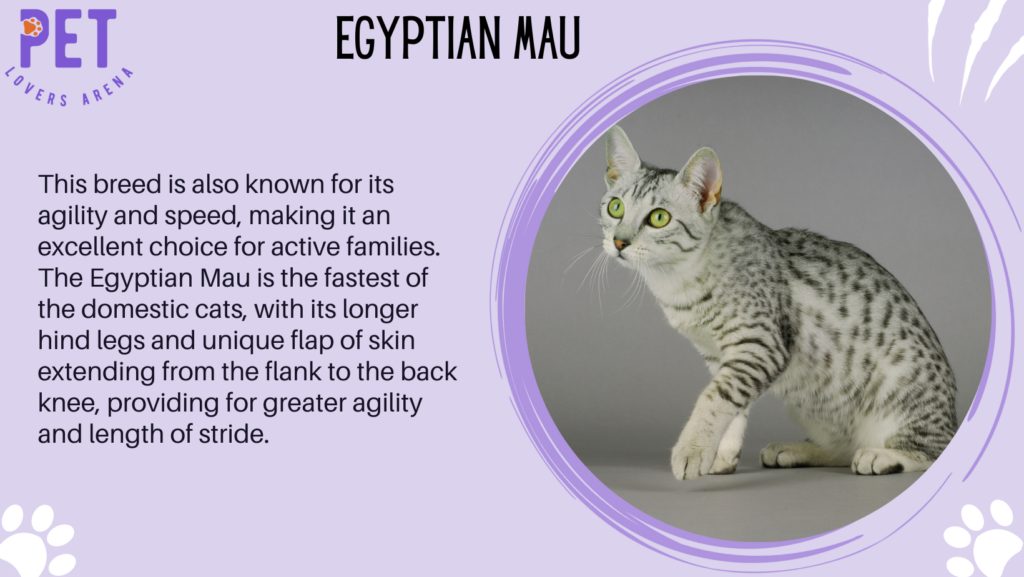
One of the unique characteristics of the Egyptian Mau is its spotted coat. This breed is also known for its agility and speed, making it an excellent choice for active families. The Egyptian Mau is the fastest of the domestic cats, with its longer hind legs and unique flap of skin extending from the flank to the back knee, providing for greater agility and length of stride.
- Scientific Name: The Egyptian Mau’s scientific name is Felis catus.
- Native Habitat: It is native to Egypt, where it has been revered for thousands of years.
- Size: Males weigh 8-14 lbs on average, and females weigh 6-10 lbs on average.
- Diet: The Egyptian Mau is a carnivore, and its diet consists of meat and fish. As with all cats, it is important to ensure that your Egyptian Mau has access to fresh water at all times.
- Lifespan: The lifespan of an Egyptian Mau is typically between 9 and 13 years.
14. Highlander
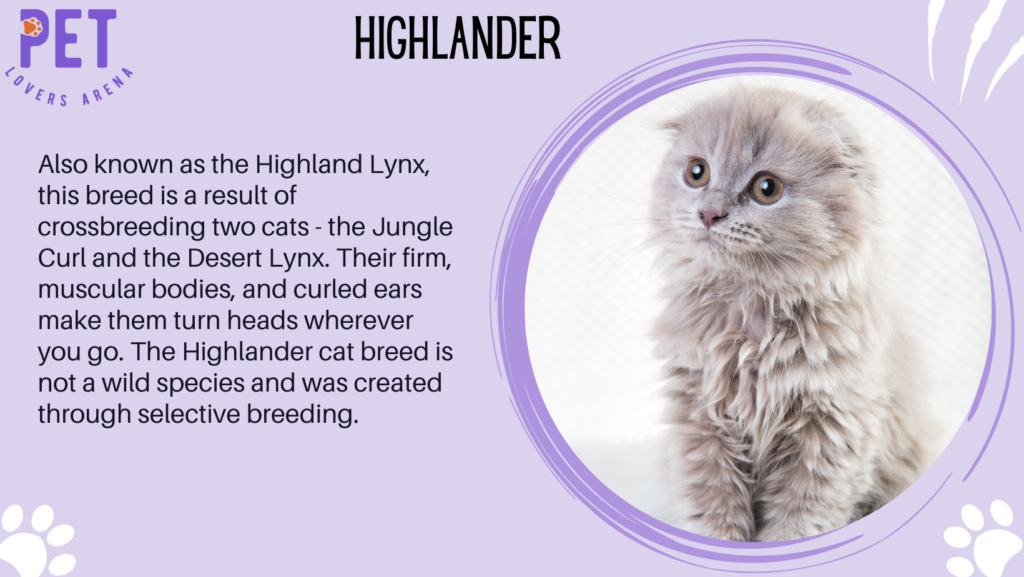
Also known as the Highland Lynx, this breed is a result of crossbreeding two cats – the Jungle Curl and the Desert Lynx. Their firm, muscular bodies, and curled ears make them turn heads wherever you go. The Highlander cat breed is not a wild species and was created through selective breeding. They are now found all over the world as domesticated pets.
- Scientific Name: The scientific name for the Highlander cat is Felis catus.
- Native Habitat: The Highlander cat breed began in the U.S. in the early 1990s.
- Size: Females can grow to between 10 and 14 pounds (4.5 and 6.4 kg), and males between 15 and 20 pounds (6.8 and 9.1 kg).
- Diet: Highlanders are carnivores and require a protein-rich diet. You can feed your Highlander with a raw or homemade diet.
- Lifespan: Highlander cats live for up to 15 years or more with proper care.
15. Savannah
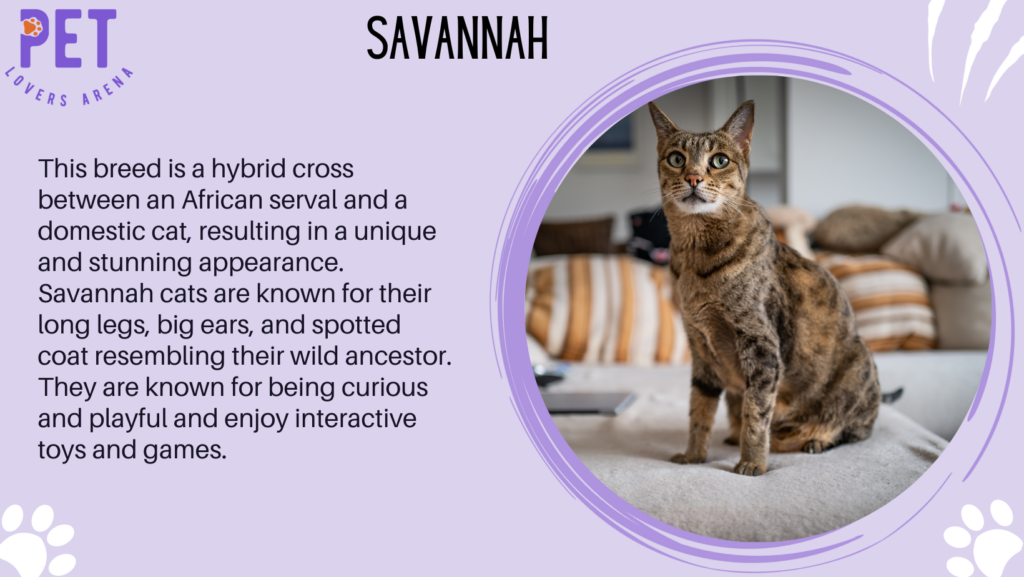
This breed is a hybrid cross between an African serval and a domestic cat, resulting in a unique and stunning appearance. Savannah cats are known for their long legs, big ears, and spotted coat resembling their wild ancestor. They are known for being curious and playful and enjoy interactive toys and games.
- Scientific Name: Felis catus x Leptailurus serval
- Native Habitat: East African plains, the South American pampas, and the open woodlands of northern Australia.
- Size: 12 to 25 pounds
- Diet: Savannah cats require a diet high in protein and low in carbohydrates. A diet that includes a variety of meats, such as chicken, turkey, and beef.
- Lifespan: Savannah cats typically live between 12 and 20 years.
16. Serengeti
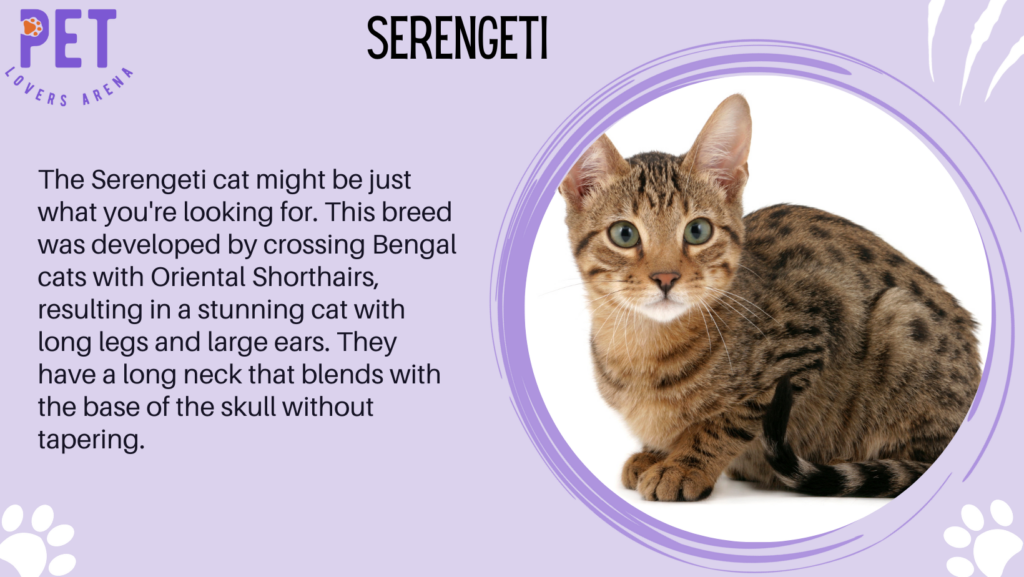
If you’re looking for an exotic-looking cat to add to your family, the Serengeti cat might be just what you’re looking for. This breed was developed by crossing Bengal cats with Oriental Shorthairs, resulting in a stunning cat with long legs and large ears. They have a long neck that blends with the base of the skull without tapering.
- Scientific Name: The scientific name for the Serengeti cat is Felis catus.
- Native Habitat: They were developed in the United States in the 1990s.
- Size: Females weigh between 3.5 and 5.5 kilograms, whilst males are slightly larger and weigh 6 to 7 kilograms.
- Diet: You can feed them cat food or a raw diet that meets their nutritional needs.
- Lifespan: The Serengeti cat has a lifespan of 8-12 years.
17. Bombay Cat
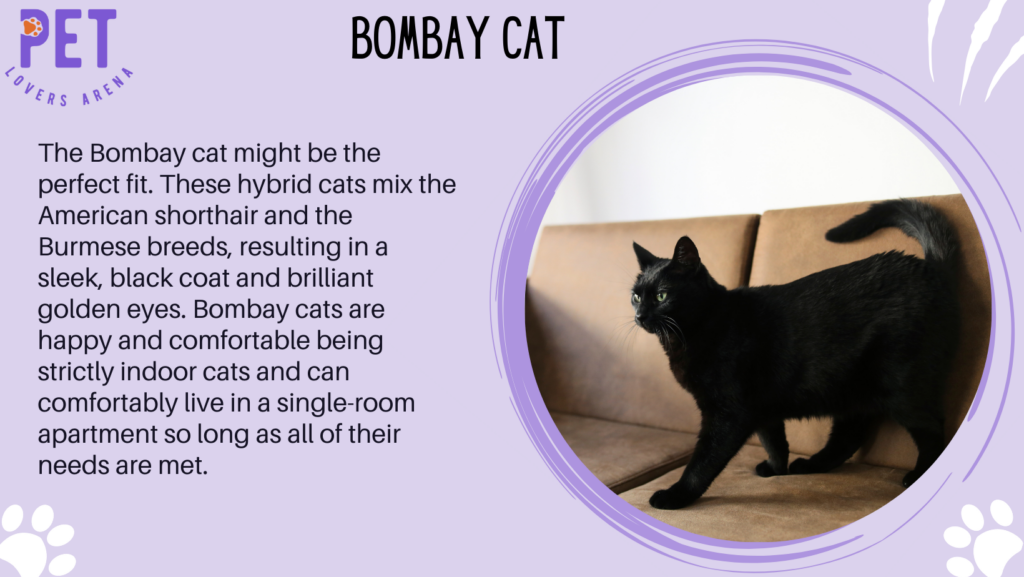
If you’re looking for a cat resembling a miniature panther, the Bombay cat might be the perfect fit. These hybrid cats mix the American shorthair and the Burmese breeds, resulting in a sleek, black coat and brilliant golden eyes. Bombay cats are happy and comfortable being strictly indoor cats and can comfortably live in a single-room apartment so long as all of their needs are met.
- Scientific Name: The scientific name for the Bombay cat is Felis catus.
- Native Habitat: They were developed in the United States in the 1950s.
- Size: 8 to 15 pounds.
- Diet: Bombay cat is a carnivore, requiring a meat diet to thrive. High-quality cat food or a balanced homemade diet is recommended.
- Lifespan: On average, the Bombay cat has a lifespan of 9-15 years.
18. Abyssinian
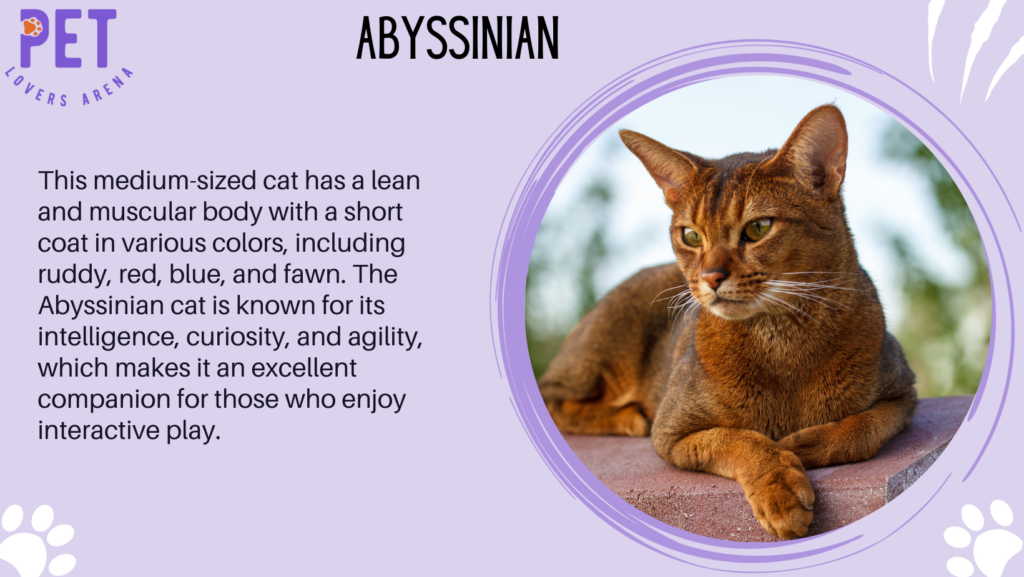
This medium-sized cat has a lean and muscular body with a short coat in various colors, including ruddy, red, blue, and fawn. The Abyssinian cat is known for its intelligence, curiosity, and agility, which makes it an excellent companion for those who enjoy interactive play. They do well in multi-cat households due to their social nature. Not a snuggly lap cat, Abyssinians are in constant motion, either exploring or playing.
- Scientific Name: The scientific name of the Abyssinian cat is Felis catus.
- Native Habitat: It is believed to have originated in Egypt.
- Size: 6-10 pounds.
- Diet: When it comes to diet, Abyssinian cats are not picky eaters. They require a balanced diet. that includes protein, fat, and carbohydrates, and enjoy a mix of wet and dry food.
- Lifespan: The lifespan of an Abyssinian cat is around 9-15 years.
19. Chausie
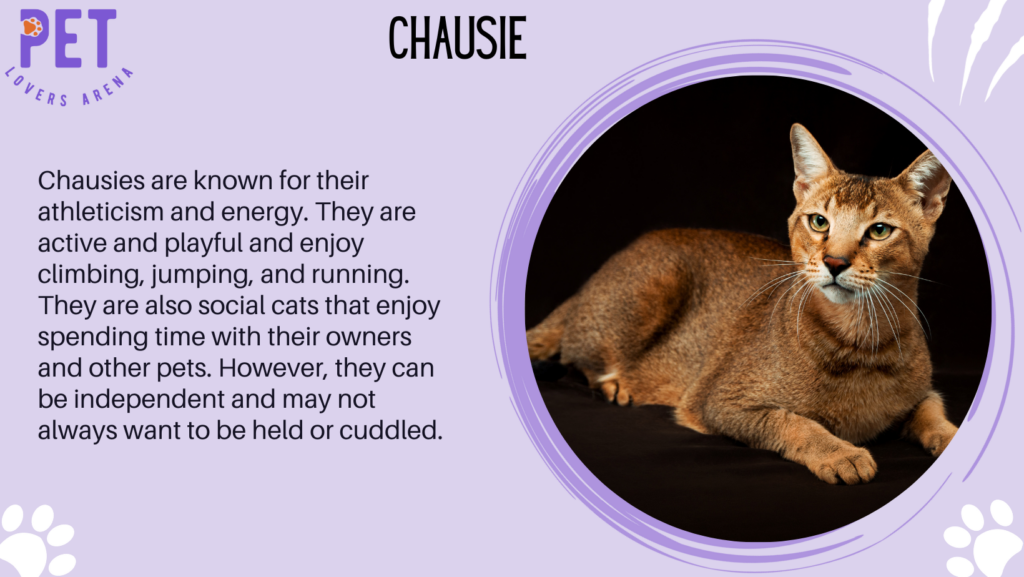
Chausies are known for their athleticism and energy. They are active and playful and enjoy climbing, jumping, and running. They are also social cats that enjoy spending time with their owners and other pets. However, they can be independent and may not always want to be held or cuddled. The Chausie is a stunningly impressive cat that makes an excellent pet for active families, homes with children, and multi-pet households.
- Scientific Name: The scientific name for the Chausie is Felis chaus x Felis catus.
- Native Habitat: The Chausie’s wild ancestors are native to Southeast Asia, including India, Sri Lanka, and Thailand. They are found in various habitats, including forests, grasslands, and wetlands.
- Size: They weigh about 25 pounds when full-grown. They can be nearly twice as tall as regular domestic cats.
- Diet: Chausies should be fed a high-quality, meat-based diet appropriate for their age and activity level. It’s important to avoid feeding them foods toxic to cats, such as chocolate, onions, and garlic.
- Lifespan: Chausies typically live for 12-15 years with proper care.
20. American Bobtail
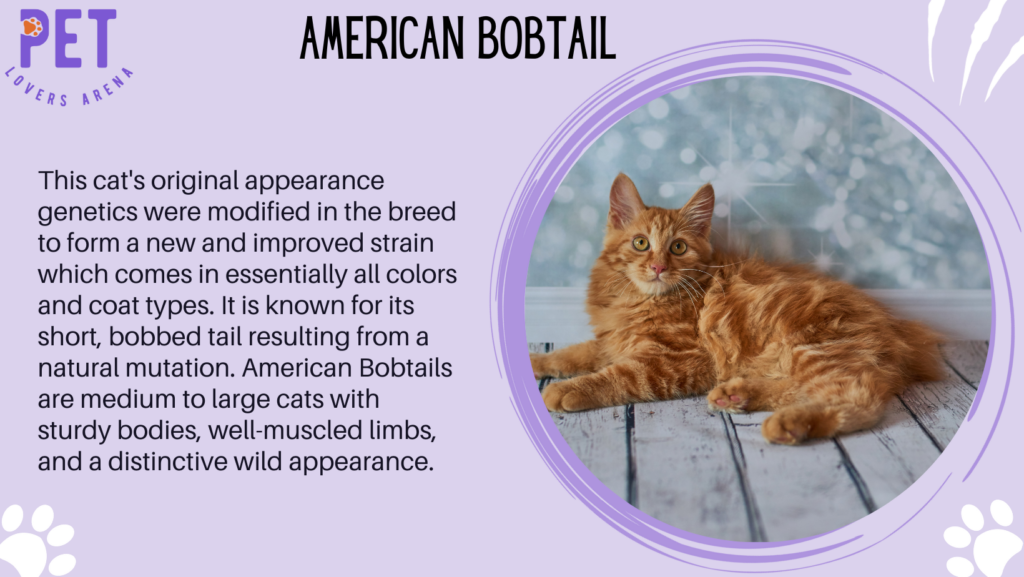
This cat’s original appearance genetics were modified in the breed to form a new and improved strain which comes in essentially all colors and coat types. It is known for its short, bobbed tail resulting from a natural mutation. American Bobtails are medium to large cats with sturdy bodies, well-muscled limbs, and a distinctive wild appearance. Their natural hunting gaze gives them an intense, focused look.
- Scientific Name: The scientific name for the American Bobtail is Felis catus.
- Native Habitat: The American Bobtail is a domestic cat breed developed in the United States in the 1960s. It is not found in the wild.
- Size: The average American Bobtail size is 7-16 pounds.
- Diet: You should feed your American Bobtail a high-quality commercial cat food formulated for their life stage (kitten, adult, or senior) and health needs. You can also give them occasional treats, but be careful not to overdo it, as too many treats can lead to obesity and other health problems.
- Lifespan: American Bobtails are generally healthy cats aged 12 to 15 years.
21. Kurilian Bobtail
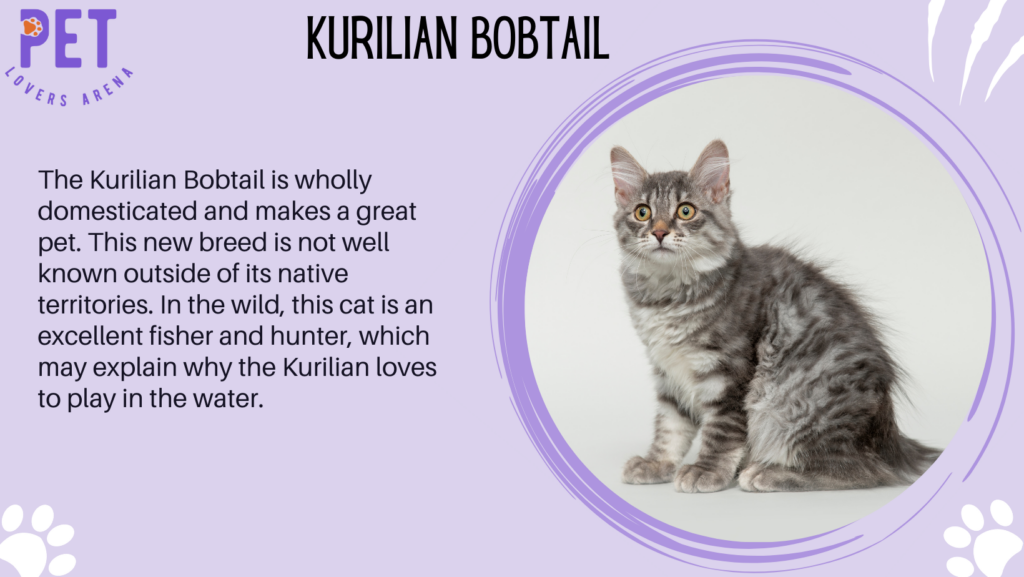
This breed is known for its wild appearance and short “pom-pom” tail, resulting from a natural genetic mutation. Despite its fantastic look, the Kurilian Bobtail is wholly domesticated and makes a great pet. This new breed is not well known outside of its native territories. In the wild, this cat is an excellent fisher and hunter, which may explain why the Kurilian loves to play in the water.
- Scientific Name: The scientific name for the Kurilian Bobtail is Felis catus.
- Native Habitat: The Kurilian Bobtail is native to the Kuril Islands, located off the coast of Russia.
- Size: Male: 11 to 15 lb Female: 8 to 11 lb
- Diet: Like all cats, the Kurilian Bobtail is a carnivore. They require a diet high in protein and fat and low in carbohydrates. You can feed your Kurilian Bobtail a commercial cat food formulated for their specific nutritional needs, or you can feed them a raw or cooked meat diet.
- Lifespan: The average lifespan of a Kurilian Bobtail is 10-15 years. With proper care and nutrition, they can live even longer.
22. Manx

One of the most distinctive features of this breed is their lack of tail or short tail. This is caused by a genetic mutation that affects the development of the spine. Manx cats can have short or long hair in various colors and patterns. They have round heads with prominent cheeks and broad chests. Manx are prized as skilled hunters and thus have often been sought by farmers with rodent problems and have been a preferred ship’s cat breed.
- Scientific Name: The scientific name for the Manx cat is Felis catus.
- Native Habitat: The breed originated on the Isle of Man, a small island off the coast of England.
- Diet: Manx cats are carnivores and require a diet that is high in protein. You can feed them a high-quality commercial cat food or a raw meat diet.
- Size: Manx cats typically weigh 8-14 pounds.
- Lifespan: The average lifespan of a Manx cat is between 9 and 13 years.
23. Pixie Bob
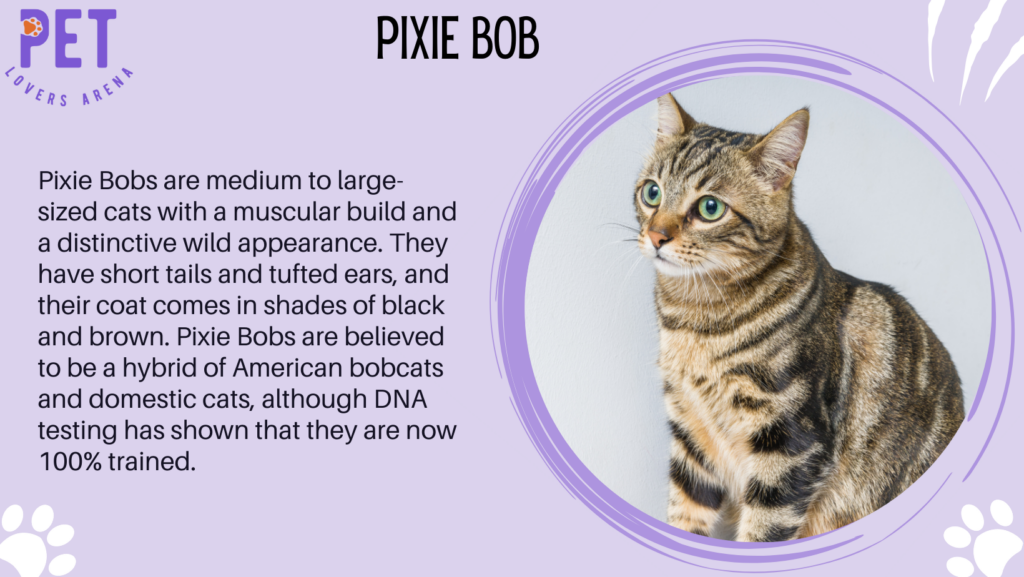
Pixie Bobs are medium to large-sized cats with a muscular build and a distinctive wild appearance. They have short tails and tufted ears, and their coat comes in shades of black and brown. Pixie Bobs are believed to be a hybrid of American bobcats and domestic cats, although DNA testing has shown that they are now 100% trained.
- Scientific Name: Felis catus
- Native Habitat: Domesticated breed originating in the United States
- Size: Males and females can both grow up to 12–13 inches tall
- Diet: High-quality cat food with occasional treats
- Lifespan: 13-16 years
24. Sphynx
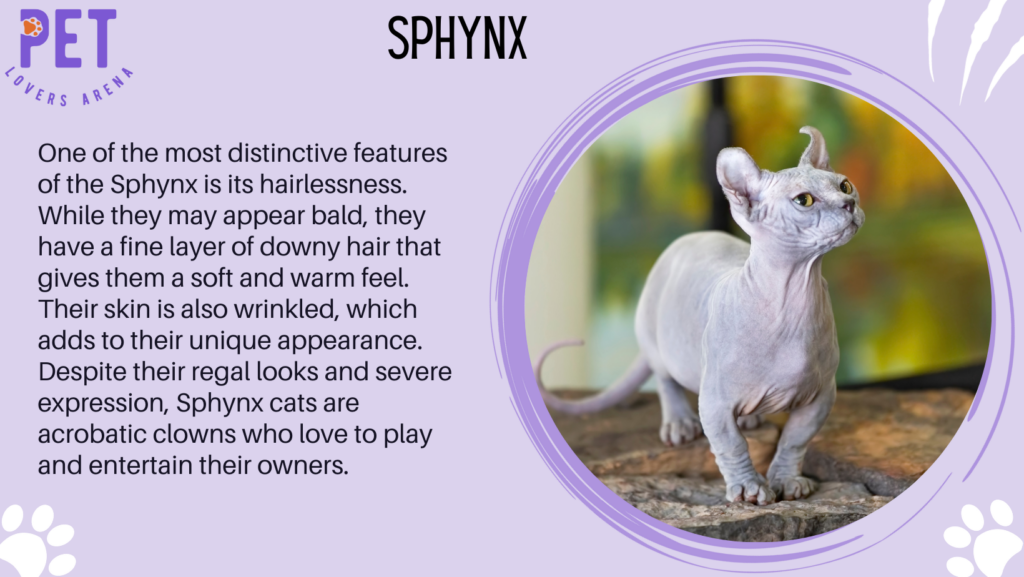
One of the most distinctive features of the Sphynx is its hairlessness. While they may appear bald, they have a fine layer of downy hair that gives them a soft and warm feel. Their skin is also wrinkled, which adds to their unique appearance. Despite their regal looks and severe expression, Sphynx cats are acrobatic clowns who love to play and entertain their owners.
- Scientific Name: Felis catus
- Native Habitat: This breed was first bred in Canada in the 1960s, but they have since become famous worldwide.
- Size: 8 to 10 inches
- Diet: Sphynx cats require a high-protein diet rich in vitamins and minerals. You can feed them commercial cat food or a raw diet that includes raw meat, organs, and bones.
- Lifespan: Sphynx cats have an average lifespan of 8 to 14 years.
25. Nebelung
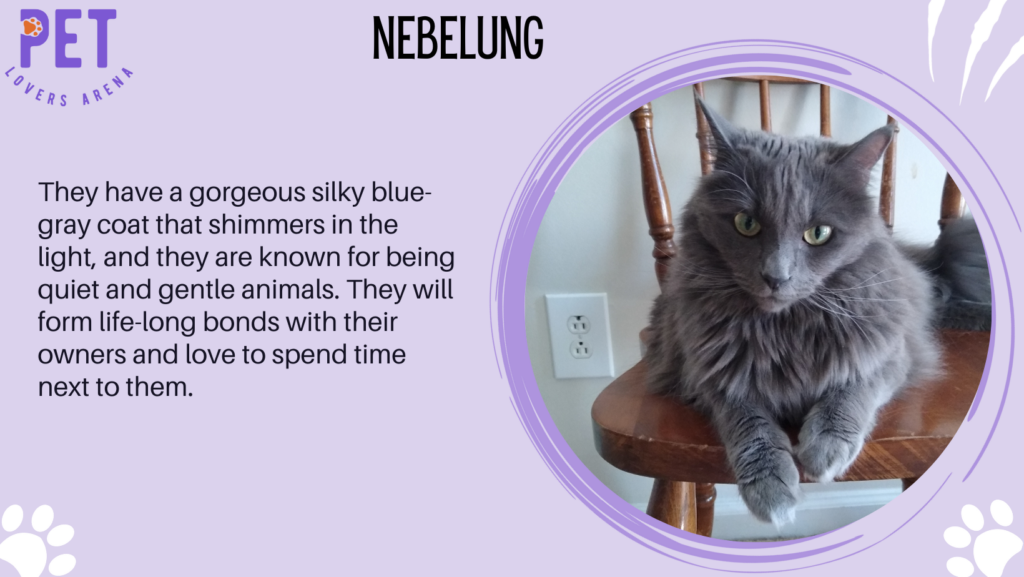
The Nebelung is a relatively new purebred line recognized by the TICA. They have a gorgeous silky blue-gray coat that shimmers in the light, and they are known for being quiet and gentle animals. They will form life-long bonds with their owners and love to spend time next to them.
They are undemanding and easy to care for, but they also have a playful side. You should ensure you have many appropriate toys and other forms of enrichment around the house to keep your feline exercised and entertained.
- Scientific Name: Felis catus
- Native Habitat: United States
- Size: They are quite muscular and, on average, weigh between 7-15 pounds.
- Diet: You can provide your Nebelung with a balanced diet by feeding them high-quality commercial cat food or by preparing homemade meals that meet their nutritional needs.
- Lifespan: Nebelung cats have a lifespan of around 15 years.
26. Turkish Van
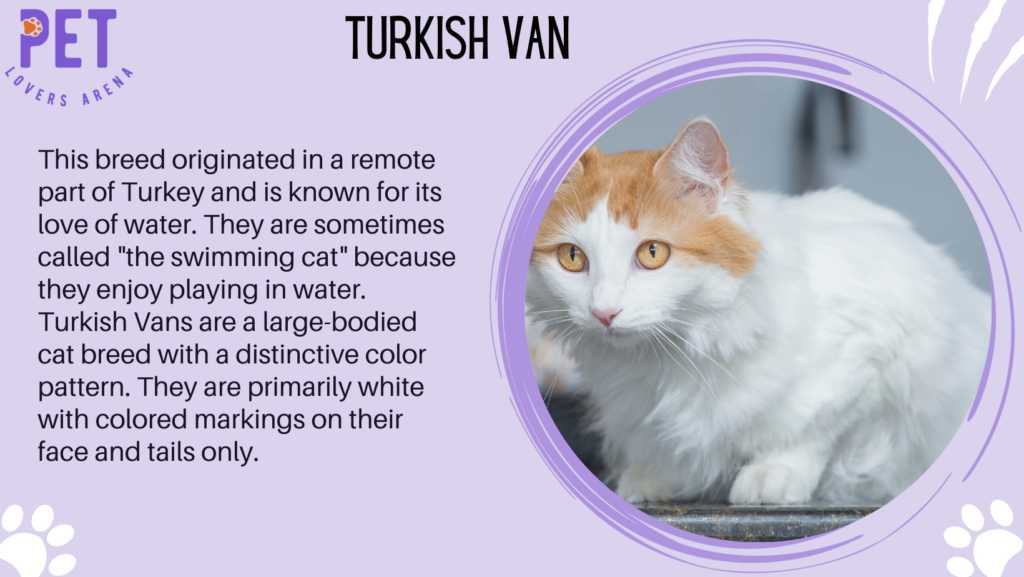
This breed originated in a remote part of Turkey and is known for its love of water. They are sometimes called “the swimming cat” because they enjoy playing in water. Turkish Vans are a large-bodied cat breed with a distinctive color pattern. They are primarily white with colored markings on their face and tails only. This pattern is so unique that when it appears in other cat breeds, it is often called a “van” pattern.
- Scientific Name: The scientific name for the Turkish Van is Felis catus.
- Native Habitat: Lake Van region (and the areas bordering it in the Armenian highlands)
- Diet: Turkish Vans are carnivores and require a diet high in protein. You can feed them a high-quality commercial cat food or a homemade diet your veterinarian approves.
- Size: males range in weight from 10 – 20 pounds, with females ranging from 7 – 12 pounds.
- Lifespan: Turkish Vans can live for 12-17 years.
How to Take Care of Exotic Cats?
Caring for exotic cats can be challenging. While some species are more adaptable to domestic life than others, it is important to understand that these cats are not like typical house cats.
First and foremost, you must provide a lot of play and attention to exotic cats. They are active animals and require plenty of mental and physical stimulation. You should provide them with toys and playtime to keep them engaged and happy.
Exotic cats also require a specific diet that you must adhere to. They need a diet that is high in protein and low in carbohydrates. You should consult with a veterinarian specializing in zoo animals to determine the appropriate diet for your cat.
Climbing and scratching are natural behaviors for cats, and exotic cats are no exception. You should provide them with appropriate furniture and climbing structures to satisfy their instincts. You should also provide them with scratching posts to prevent them from damaging household objects.
Exotic cats can be temperamental and may have disciplinary issues. It is important to establish boundaries and train them from a young age. However, it is important to note that some species, such as the Serval, are more trainable than others.
How to Rehome an Exotic Cat?
If you need to rehome your exotic cat, there are a few things you should consider. First, it’s essential to understand that not all exotic cats are suitable pets. Some exotic cats, such as tigers and lions, are dangerous and illegal to own in most states.
Therefore, you must remove any exotic cat that does not fit as a pet and give detailed information on the one that is suitable to keep as a pet.
Assuming that you have an exotic cat that is legal to own as a pet, the first step in rehoming your cat is to find a new owner. You can do this by advertising your cat on social media, online classifieds, or by contacting exotic animal rescue organizations.
It’s essential to be honest about your cat’s behavior, health, and any special needs they may have when advertising them for adoption.
What to Consider Before Buying an Exotic Cat?
Before buying an exotic cat pet, there are several things that you should consider to ensure that you are making the right decision and that you can provide the care that your pet will need.
First and foremost, it is important to research the laws in your state and local area regarding the ownership of exotic animals. Some states have strict rules and regulations regarding the ownership of exotic cats and require special licenses or permits. Ensure you know all the legal requirements before you bring a strange cat into your home.
Next, it is important to consider the behavior and traits of the exotic cat you are interested in. Some exotic cats are unsuitable due to their wild nature and aggressive behavior. It is important to choose a cat known to be docile and friendly towards humans.
You should also consider the living conditions that your exotic cat will require. Many exotic cats require large enclosures, specialized diets, and regular veterinary care. Make sure you can provide the appropriate living conditions and care for your pet before you commit to owning an exotic cat.
Another important factor to consider is whether or not you have children in your home. Some exotic cats may not be suitable for homes with young children due to their size and temperament. Choosing a cat known to be gentle and patient with children is important.
Finally, it is important to understand that owning an exotic cat is a big responsibility and requires significant time, money, and effort. You will need to bond with your pet and provide it with the care and attention it needs to thrive in captivity.
FAQ’s
The Maine Coon is the most giant domesticated cat breed, with males growing to around 18 pounds. They frequently earn Guinness World Record accolades for most giant, tallest, and longest cats.
Hybrid cats, including the Savannah and Bengal cats, are exotic pets that California residents can own. A hybrid cat is the offspring of a domestic cat and an Asian leopard cat or a serval. In some states, you can only own hybrid cats if they are F5s or higher, meaning they belong to the fifth generation.
The cost of owning an exotic cat can vary depending on the breed and the cost of living in your area. You can expect to pay several thousand dollars to purchase an unfamiliar cat, and ongoing expenses such as food, litter, and veterinary care can add up quickly. It is essential to budget carefully and be prepared for unexpected costs.
Yes, there are restrictions on owning exotic cats in certain states. Some states have banned the ownership of certain exotic cat breeds altogether. In contrast, others require permits or have specific regulations in place. It is important to research the laws in your state before considering owning an exotic cat.
Conclusion
In conclusion, owning an exotic cat can be a unique and rewarding experience for the right person. However, it is important to remember that not all exotic cat breeds in the United States are legal to keep as pets. Research local laws and regulations before bringing an exotic cat into your home.
Meet Fabian Wright, our guide into the animal realm at PetLoversArena.com. Having served as an Animal Care Specialist for the Ruwenzori Team at the Kansas City Zoo, he prioritizes conserving exotic species by replicating their habitats. Fabian aspires to share captivating stories of creatures, big and small, through PetLoversArena.com.

